Quantifying Spatiotemporal Characteristics and Identifying Influential Factors of Ecosystem Fragmentation in Karst Landscapes: A Comprehensive Analytical Framework
Abstract
1. Introduction
2. Materials and Methods
2.1. Study Area
2.2. Data Sources and Processing
2.3. Research Methods
2.3.1. Landscape Pattern Analysis
2.3.2. Landscape Fragmentation Index Construction
- (1)
- For normalized decision matrices B = (bij)m × n, make:
- (2)
- The information entropy value of the attribute output is:when pij = 0, it is specified that pij ln pij = 0, then: 0 ≤ hj ≤ 1.
- (3)
- Calculation of the coefficient of variation of the attribute dj:
- (4)
- Calculating attribute weighting coefficient:
2.3.3. Geographic Probe
2.3.4. Multiscale Geographically Weighted Regression Model
2.3.5. PLUS Model
3. Results
3.1. Characteristics of Landscape Pattern Change
3.2. Analysis of the Spatiotemporal Pattern of the Composite Index of Landscape Fragmentation
3.3. Exploring the Causes of Landscape Fragmentation and Spatial Nonsmoothness
3.4. Patterns of Spatiotemporal Variation in Landscape Fragmentation under Different Scenarios
4. Discussion
4.1. Specificity Analysis
4.2. Insights and Suggestions for Ecological Management
4.3. Pervasive Contributions and Limitations
5. Conclusions
Author Contributions
Funding
Data Availability Statement
Conflicts of Interest
References
- Lv, X.; Xiao, W.; Zhao, Y.; Zhang, W.; Li, S.; Sun, H. Drivers of spatio-temporal ecological vulnerability in an arid, coal mining region in Western China. Ecol. Indic. 2019, 106, 105475. [Google Scholar] [CrossRef]
- Di Febbraro, M.; Bosso, L.; Fasola, M.; Santicchia, F.; Aloise, G.; Lioy, S.; Bertolino, S. Different facets of the same niche: Integrating citizen science and scientific survey data to predict biological invasion risk under multiple global change drivers. Glob. Change Biol. 2023, 29, 5509–5523. [Google Scholar] [CrossRef]
- Zhang, L.; Sun, P.; Huettmann, F.; Liu, S. Where should China practice forestry in a warming world? Glob. Change Biol. 2022, 28, 2461–2475. [Google Scholar] [CrossRef]
- Hussain, S.; Huang, J.; Huang, J.; Ahmad, S.; Nanda, S.; Anwar, S.; Zhang, J. Rice production under climate change: Adaptations and mitigating strategies. In Environment, Climate, Plant and Vegetation Growth; Springer: Cham, Switzerland, 2020; pp. 659–686. [Google Scholar]
- Zhang, Z.; Wang, X.; Zhang, Y.; Gao, Y.; Liu, Y.; Sun, X.; Yin, S. Simulating land use change for sustainable land management in rapid urbanization regions: A case study of the Yangtze River Delta region. Landsc. Ecol. 2023, 38, 1807–1830. [Google Scholar] [CrossRef]
- Duan, X.; Chen, Y.; Wang, L.; Zheng, G.; Liang, T. The impact of land use and land cover changes on the landscape pattern and ecosystem service value in Sanjiangyuan region of the Qinghai-Tibet Plateau. J. Environ. Manag. 2023, 325, 116539. [Google Scholar] [CrossRef]
- Liang, J.L.; Chen, W.X.; Li, J.F.; Dong, M.J.; Zhou, T.; Pan, S.P. Spatiotemporal patterns of landscape fragmentation and causes in the Yellow River Basin. J. Ecol. 2022, 42, 1993–2009. [Google Scholar]
- Deng, Z.; Quan, B. Intensity Analysis to Communicate Detailed Detection of Land Use and Land Cover Change in Chang-Zhu-Tan Metropolitan Region, China. Forests 2023, 14, 939. [Google Scholar] [CrossRef]
- Chi, Q.; Zhou, S.; Wang, L.; Zhu, M.; Liu, D.; Tang, W.; Lee, J. Exploring on the eco-climatic effects of land use changes in the influence area of the Yellow River Basin from 2000 to 2015. Land 2021, 10, 601. [Google Scholar] [CrossRef]
- Zou, L.; Wang, J.; Bai, M. Assessing spatial–temporal heterogeneity of China’s landscape fragmentation in 1980–2020. Ecol. Indic. 2022, 136, 108654. [Google Scholar] [CrossRef]
- De Montis, A.; Serra, V.; Ganciu, A.; Ledda, A. Assessing landscape fragmentation: A composite indicator. Sustainability 2020, 12, 9632. [Google Scholar] [CrossRef]
- Wang, K.; Zhang, C.; Chen, H.; Yue, Y.; Zhang, W.; Zhang, M.; Fu, Z. Karst landscapes of China: Patterns, ecosystem processes and services. Landsc. Ecol. 2019, 34, 2743–2763. [Google Scholar] [CrossRef]
- Qiu, S.; Peng, J.; Zheng, H.; Xu, Z.; Meersmans, J. How can massive ecological restoration programs interplay with social-ecological systems? A review of research in the South China karst region. Sci. Total Environ. 2022, 807, 150723. [Google Scholar] [CrossRef]
- Hu, C.; Liu, Z.; Xiong, K.; Lyu, X.; Li, Y.; Zhang, R. Temporal and Spatial Variations in Carbon/Nitrogen Output in the Karst Critical Zone and Its Response to the Forest Ecosystem of Karst Desertification Control. Forests 2023, 14, 1121. [Google Scholar] [CrossRef]
- Chen, J. Analysis on the Evolution and Driving Force of Landscape Pattern in Karst Region-Take Zhenfeng County, Guanling County, Guizhou Province as an Example. Master’s Thesis, Guizhou Normal University, Guiyang, China, 2020. [Google Scholar]
- Li, Y.; Geng, H. Evolution of land use landscape patterns in karst watersheds of Guizhou Plateau and its ecological security evaluation. Land 2022, 11, 2225. [Google Scholar] [CrossRef]
- Wang, Z.; Dai, L. Assessment of land use/cover changes and its ecological effect in karst mountainous cities in central Guizhou Province: Taking Huaxi District of Guiyang City as a case. Acta Ecol. Sin. 2021, 41, 3429–3440. [Google Scholar]
- Jiao, L.M.; Xiao, F.T.; Xu, G.; Lu, Y.N. Spatial-temporal response of green land fragmentation patterns to urban expansion in Wuhan metropolitan area. Resour. Sci. 2015, 37, 1650–1660. [Google Scholar]
- SHI, X.; He, J. The spatial-temporal evolution characteristics of landscape fragmentation in Fenhe River Basin. J. Nat. Resour. 2019, 34, 1606–1619. [Google Scholar]
- Cui, S.; Han, Z.; Yan, X.; Li, X.; Zhao, W.; Liu, C.; Zhong, J. Link ecological and social composite systems to construct sustainable landscape patterns: A new framework based on ecosystem service flows. Remote Sens. 2022, 14, 4663. [Google Scholar] [CrossRef]
- Liu, C.; Zhang, F.; Johnson, V.C.; Duan, P. Spatio-temporal variation of oasis landscape pattern in arid area: Human or natural driving? Ecol. Indic. 2021, 125, 107495. [Google Scholar] [CrossRef]
- Xiong, C.; Wu, Z.; Zeng, Z.; Gong, J.; Li, J. Spatiotemporal evolution of forest landscape pattern in Guangdong-Hong Kong-Macao Greater Bay Area based on “Spatial Morphology-Fragmentation-Aggregation”. Acta Ecol. Sin. 2023, 43, 3032–3044. [Google Scholar]
- Yang, W.R. Spatiotemporal change and driving forces of urban landscape pattern in Beijing. Acta Ecol. Sin. 2015, 35, 4357–4366. [Google Scholar]
- Zhang, J.; Gong, J.; Liu, D. Dynamics and Driving Factors of Landscape Fragmentation Based on Geo Detector in the Bailongjiang Watershed of Gansu Province. Sci. Geogr. Sin. 2018, 38, 1370–1378. [Google Scholar]
- Zheng, L.; Wang, Y.; Li, J. Quantifying the spatial impact of landscape fragmentation on habitat quality: A multi-temporal dimensional comparison between the Yangtze River Economic Belt and Yellow River Basin of China. Land Use Policy 2023, 125, 106463. [Google Scholar] [CrossRef]
- Shi, F.; Liu, S.; An, Y.; Sun, Y. Changes of landscape fragmentation and connectivity with urbanization: A case study of Kunming City. Acta Ecol. Sin. 2020, 40, 3303–3314. [Google Scholar]
- Biswas, G.; Sengupta, A.; Alfaisal, F.M.; Alam, S.; Alharbi, R.S.; Jeon, B.H. Evaluating the effects of landscape fragmentation on ecosystem services: A three-decade perspective. Ecol. Inform. 2023, 77, 102283. [Google Scholar] [CrossRef]
- Riva, F.; Fahrig, L. Landscape-scale habitat fragmentation is positively related to biodiversity, despite patch-scale ecosystem decay. Ecol. Lett. 2023, 26, 268–277. [Google Scholar] [CrossRef] [PubMed]
- Turner, M.; Gardner, R. Quantitative Methods in Landscape Ecology: The Analysis and Interpretation of Landscape Heterogeneity; Springer: New York, NY, USA, 1991; Volume 82. [Google Scholar]
- Wu, L.; He, D.; You, W.; Ji, Z.; Huang, X. A gradient analysis of coastal landscape fragmentation change in Dongshan island, China. Acta Ecol. Sin. 2020, 40, 1055–1064. [Google Scholar]
- Qiu, L.; Tao, T.; Han, S.; Yang, W.Y. Effects of local landscape fragmentation on species richness at a macroecological scale. Acta Ecol. Sin. 2017, 37, 7595–7603. [Google Scholar]
- Lin, J.; Duo, L.; Zou, Z. Dynamic Evolution and Spatial Autocorrelation Analysis of Landscape Fragmentation Under the Background of Urban Expansion-A Case Study of Nanchang City. Res. Soil. Water Conserv. 2022, 29, 362–369. [Google Scholar]
- Shen, R. The Evolution of Landscape Fragmentation and Construction of the Ecological Security Pattern in Xishuangbanna; Yunnan Normal University: Kunming, Yunnan, 2021. [Google Scholar]
- Chen, W.; Xia, J. An Optimal Weights Combination Method Considering both Subjective and Objective Weight Information. Math. Pract. Theory 2007, 37, 17–22. [Google Scholar]
- Xu, C.; Lu, C.; Huang, S. Study on ecological vulnerability and its influencing factors in Zhang Jiakou area. J. Nat. Resour. 2020, 35, 1288–1300. [Google Scholar]
- Xu, H.Q. A remote sensing urban ecological index and its application. Acta Ecol. Sin. 2013, 33, 7853–7862. [Google Scholar]
- Zhao, J.; Cui, L.; Wang, J.; Chen, S. Muli-scenario simulation of urban gren space development and construction Timeline based on PLUS model analysis: A case study of the central Zhan Jiang City. Acta Ecol. Sin. 2023, 43, 1–14. [Google Scholar]
- Zhang, X.; Brandt, M.; Yue, Y.; Tong, X.; Wang, K.; Fensholt, R. The Carbon Sink Potential of Southern China After Two Decades of Afforestation. Earth Future 2022, 10, e2022EF002674. [Google Scholar] [CrossRef] [PubMed]
- Freitas, S.; Hawbaker, T.; Metzger, J. Effects of roads, topography, and land use on forest cover dynamics in the Brazilian Atlantic Forest. Forest. Ecol. Manag. 2009, 259, 410–417. [Google Scholar] [CrossRef]
- Shao, J.; Li, Y.; Meng, Y. Pedo diversity in karst area of Chongqing, China. Acta Ecol. Sin. 2007, 27, 2048–2058. [Google Scholar]
- Whipple, K.; Tucker, G. Dynamics of the stream-power river incision model: Implications for height limits of mountain ranges, landscape response timescales, and research needs. J. Geophys. Res. Solid. Earth 1999, 104, 17661–17674. [Google Scholar] [CrossRef]
- Charlton, M.; Fotheringham, S.; Brunsdon, C. Geographically Weighted Regression White Paper; National University of Ireland Maynooth: Kildare, Ireland, 2009; 14. [Google Scholar]
- Fotheringham, A.; Yang, W.; Kang, W. Multiscale geographically weighted regression (MGWR). Ann. Am. Assoc. 2020, 107, 1247–1265. [Google Scholar] [CrossRef]
- Oshan, T.; Li, Z.; Kang, W. A python implementation of multiscale geographically weighted regression for investigating process spatial heterogeneity and scale. ISPRS Int. J. GeoInformation 2019, 8, 269. [Google Scholar] [CrossRef]
- Schiff, J.L. Cellular Automata. A Discrete View of the World; John Wiley & Sons: Hoboken, NJ, USA, 2008. [Google Scholar]
- Liu, X.; Liang, X.; Li, X.; Xu, X.; Ou, J.; Chen, Y. A future land use simulation model (FLUS) for simulating multiple land use scenarios by coupling human and natural effects. Landsc. Urban. Plan. 2017, 168, 94–116. [Google Scholar] [CrossRef]
- Motlagh, Z.; Lotfifi, A.; Pourmanafifi, S.; Ahmadizadeh, S.; Soffifianian, A. Spatial modeling of land-use change in a rapidly urbanizing landscape in Central Iran: Integration of remote sensing, CA-markov, and landscape metrics. Environ. Monit. Assess. 2020, 192, 1–19. [Google Scholar] [CrossRef]
- Lv, L.; Zhang, J.; Peng, Q.; Ren, P.; Jiang, Y. Landscape pattern analysis and prediction in the Dong Jiang River Basin. Acta Ecol. Sin. 2019, 39, 6850–6859. [Google Scholar]
- Chen, L.; Cai, H.; Zhang, T.; Zhang, X.; Zeng, H. Land use multi-scenario simulation analysis of Rao River Basin based on Markov-FLUS mode. Acta Ecol. Sin. 2022, 42, 3947–3958. [Google Scholar]
- Li, C.; Wu, Y.; Gao, B. Multi-scenario simulation of ecosystem service value for optimization of land use in the Sichuan-Yunnan ecological barrier, China. Ecol. Indic. 2021, 132, 108328. [Google Scholar] [CrossRef]
- Ma, J.; Li, J.; Wu, W.; Liu, J. Global forest fragmentation change from 2000 to 2020. Nat. Commun. 2023, 14, 3752. [Google Scholar] [CrossRef]
- Almeida, D.R.; Stark, S.C.; Schietti, J.; Camargo, J.L.; Amazonas, N.T.; Gorgens, E.B.; Brancalion, P.H. Persistent effects of fragmentation on tropical rainforest canopy structure after 20 yr of isolation. Ecol. Appl. 2019, 29, e01952. [Google Scholar] [CrossRef]
- Adams, A.B.; Pontius, J.; Galford, G.; Gudex-Cross, D. Simulating forest cover change in the northeastern US: Decreasing forest area and increasing fragmentation. Landsc. Ecol. 2019, 34, 2401–2419. [Google Scholar] [CrossRef]
- Wan, J.; Cai, Y.; Zhang, H.; Rao, S. Land Use/Land Cover Change and Soil Erosion Impact of Karst Area in Guanling County, Guizhou Province. Sci. Geogr. Sin. 2004, 24, 573–579. [Google Scholar]
- Zhang, Y.; Ma, Y. Spatio-temporal changes analysis of vegetation coverage in Alar City in 1992–2019 years. Grassl. Turf. 2022, 42, 62–72. [Google Scholar]
- Wu, L.; Zhou, Z. Response of Landscape Pattern Change to Habitat Quality in Karst Area. Environ. Sci. Technol. 2023, 46, 206–217. [Google Scholar]
- He, L.; Zhou, D. Impact of human disturbance on fragmentation of village-level landscape. Chin. J. Appl. Ecol. 2001, 12, 897–899. [Google Scholar]
- Cai, Y.; Meng, J. Ecological reconstruction of degraded land: A social approach. Sci. Geogr. Sin. 1999, 19, 198–204. [Google Scholar]
- Ren, B.; Park, K.; Shrestha, A.; Yang, J.; McHale, M.; Bai, W.; Wang, G. Impact of Human Disturbances on the Spatial Heterogeneity of Landscape Fragmentation in Qilian Mountain National Park, China. Land 2022, 11, 2087. [Google Scholar] [CrossRef]
- Li, S.; Ma, W.; Gu, Y.; Wen, H.; Peng, Y.; Li, C. Analysis of spatial-temporal changes in landscape fragmentation in the Ningxia Yellow River Valley. Acta Ecol. Sin. 2016, 36, 3312–3320. [Google Scholar]
- Seidl, N.P.; Golobič, M. Quantitative assessment of agricultural landscape heterogeneity. Ecol. Indic. 2020, 112, 106115. [Google Scholar] [CrossRef]
- Canedoli, C.; Crocco, F.; Comolli, R.; Padoa-Schioppa, E. Landscape fragmentation and urban sprawl in the urban region of Milan. Landsc. Res. 2018, 43, 632–651. [Google Scholar] [CrossRef]
- Zhang, S.; Xiong, K.; Yao, Q.; Min, X.; Jie, X. Evolution and determinants of ecosystem services: Insights from South China karst. Ecol. Indic. 2021, 133, 108437. [Google Scholar] [CrossRef]
- Bestelmeyer, B. Threshold concepts and their use in rangeland management and restoration: The good, the bad, and the insidious. Restor. Ecol. 2006, 14, 325–329. [Google Scholar] [CrossRef]
- Geri, F.; Amici, V.; Rocchini, D. Human activity impact on the heterogeneity of a Mediterranean landscape. Appl. Geogr. 2010, 30, 370–379. [Google Scholar] [CrossRef]
- Wan, J.; Cai, Y. Land Degradation and Ecological-Reconstruction in Fragile Karst Ecosystem: The Case of Guanling County, Guizhou Province. China Popul. Resour. Environ. 2003, 13, 52–56. [Google Scholar]
- Jiang, P.; Chen, D.; Li, M. Farmland landscape fragmentation evolution and its driving mechanism from rural to urban: A case study of Changzhou City. J. Rural. Stud. 2021, 82, 1–18. [Google Scholar]
- Wang, H.; Liu, X.; Zhao, C.; Chang, Y.; Liu, Y.; Zang, F. Spatial-temporal pattern analysis of landscape ecological risk assessment based on land use/land cover change in Baishuijiang National nature reserve in Gansu Province. China Ecol. Indic. 2021, 124, 107454. [Google Scholar] [CrossRef]
- Li, R.; Wang, S.; Zhou, D.; Zhang, D.; Li, F.; Zhou, Z.; Xiong, K. The Correlation between Rock Desertification and Lithology in Karst Area of Guizhou. Acta Geogr. Sin. 2003, 58, 314–320. [Google Scholar]
- Gao, L.; Tao, F.; Liu, R.; Wang, Z.; Leng, H.; Zhou, T. Multi-scenario simulation and ecological risk analysis of land use based on the PLUS model: A case study of Nan Jing. Sustain. Cities. Soc. 2022, 85, 104055. [Google Scholar] [CrossRef]
- Zhu, M.; Zhou, Z.; Feng, Q.; Wu, X.; Liu, R.; Wu, G.; Luo, W. Contribution of vegetation restoration to carbon sequestration driven by ex-situ poverty alleviation and relocation in ecologically fragile areas-Taking Guizhou, China, as a case. Land Degrad. Dev. 2023, 34, 3905–3919. [Google Scholar] [CrossRef]
- Lou, H.; Yang, S.; Shi, X.; Zhang, J.; Pan, Z.; Li, C. Whether the enhanced terrestrial vegetation carbon sink affect the water resources in the middle-low latitude karst areas of China? J. Hydrol. 2023, 620, 129510. [Google Scholar] [CrossRef]
- Tong, X.; Brandt, M.; Yue, Y.; Horion, S.; Wang, K. Increased Vegetation Growth and Carbon Stock in China Karst Via Ecological Engineering. Nat. Sustain. 2018, 20181, 44–50. [Google Scholar] [CrossRef]
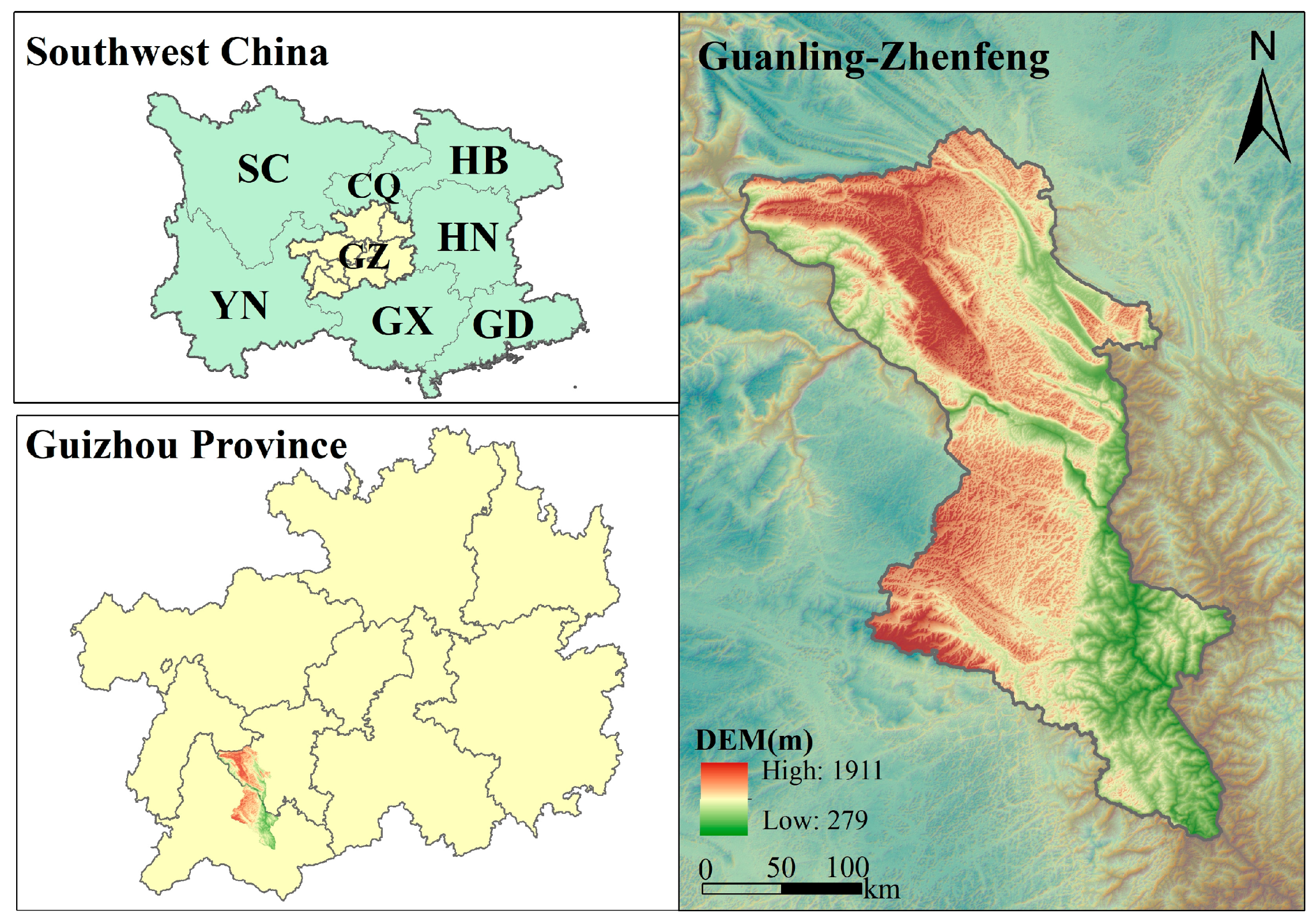
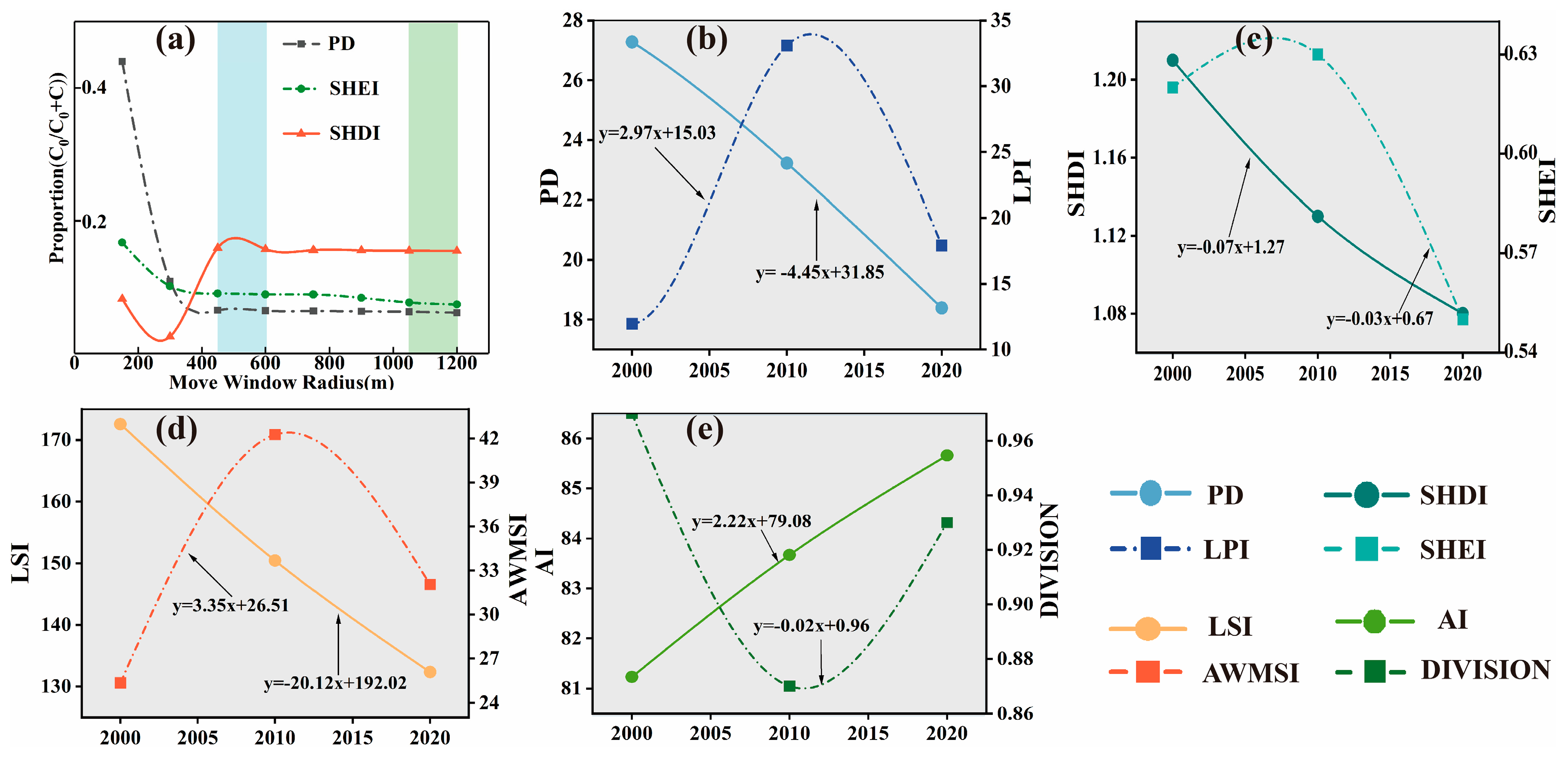
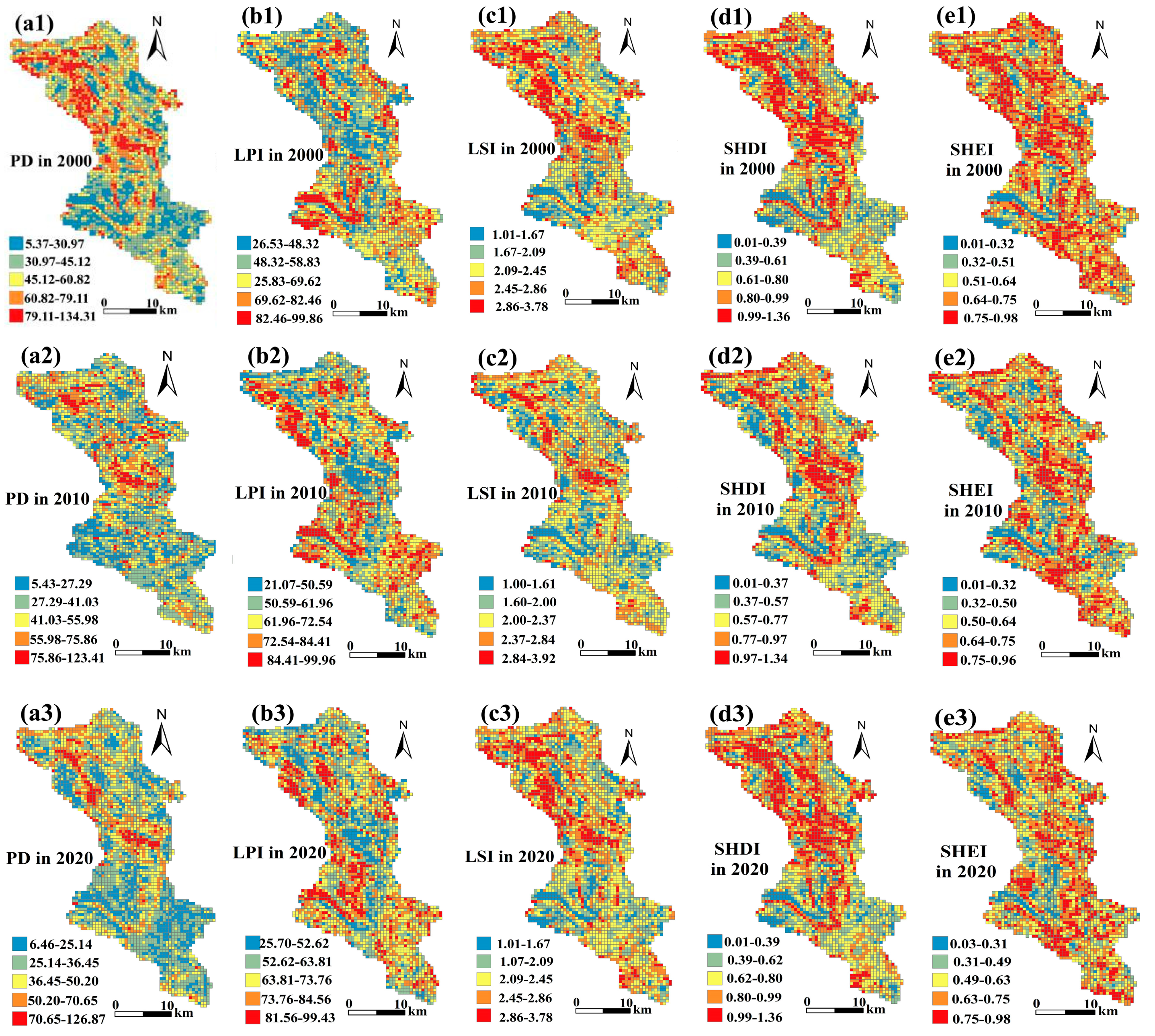
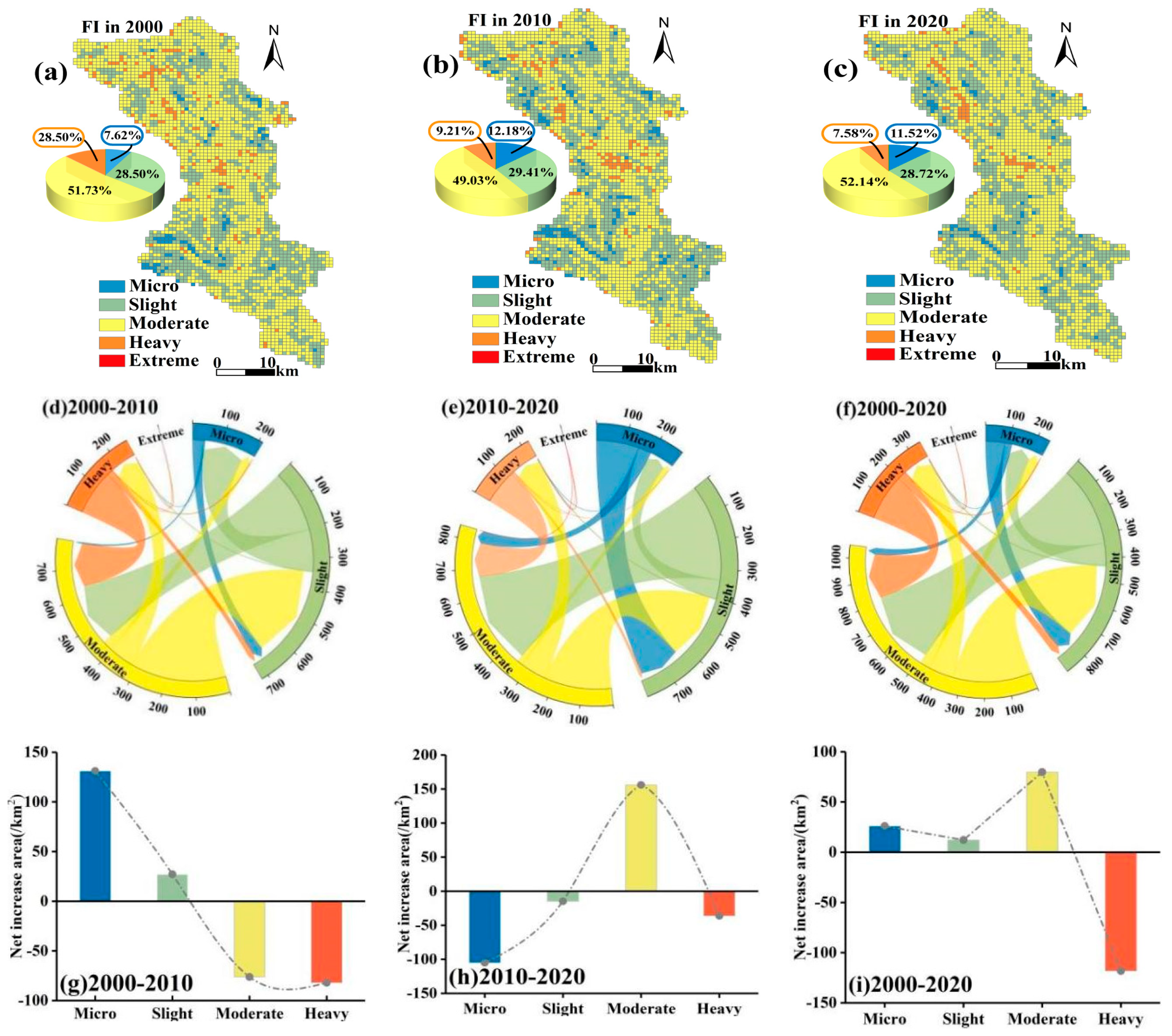
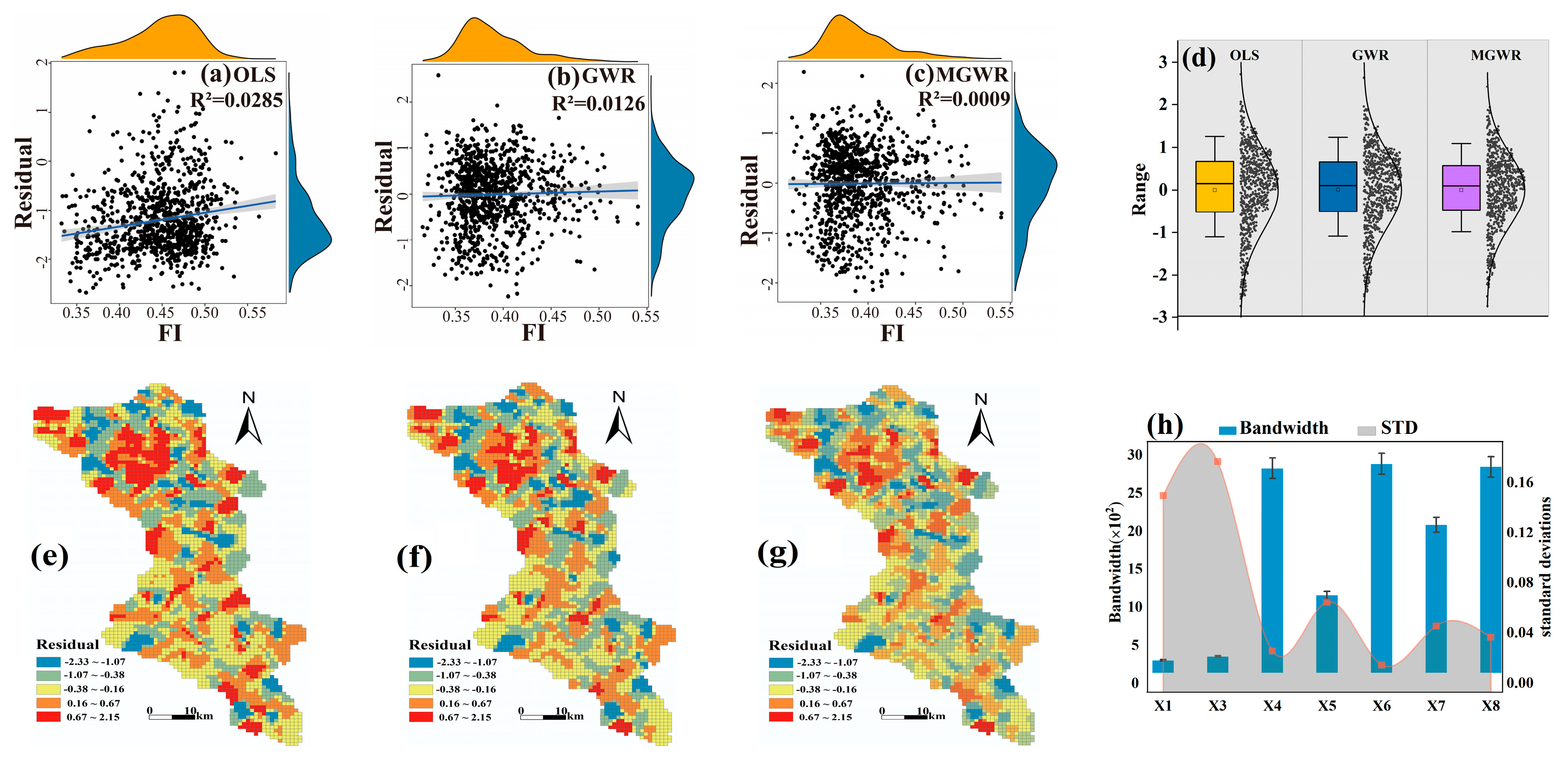
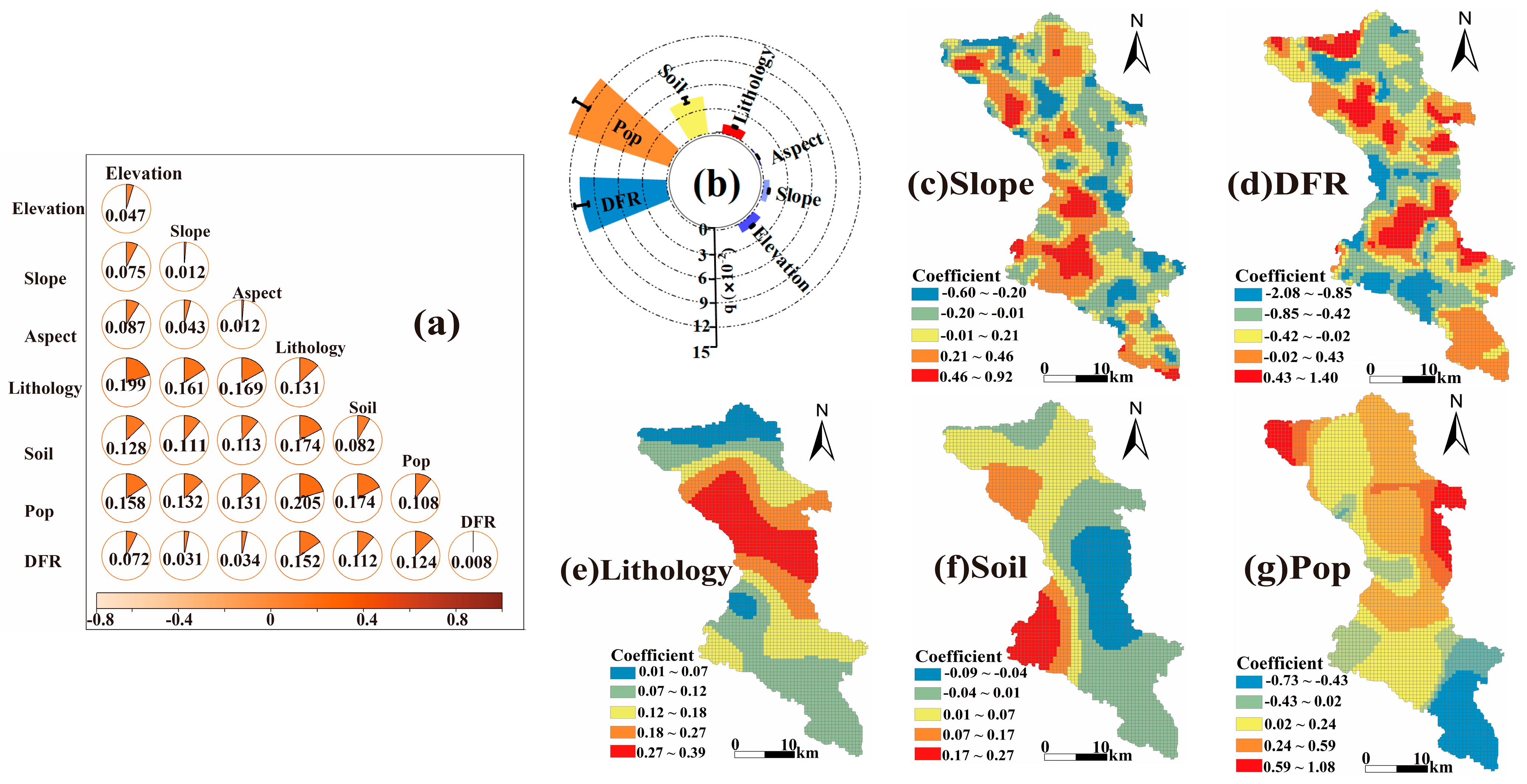
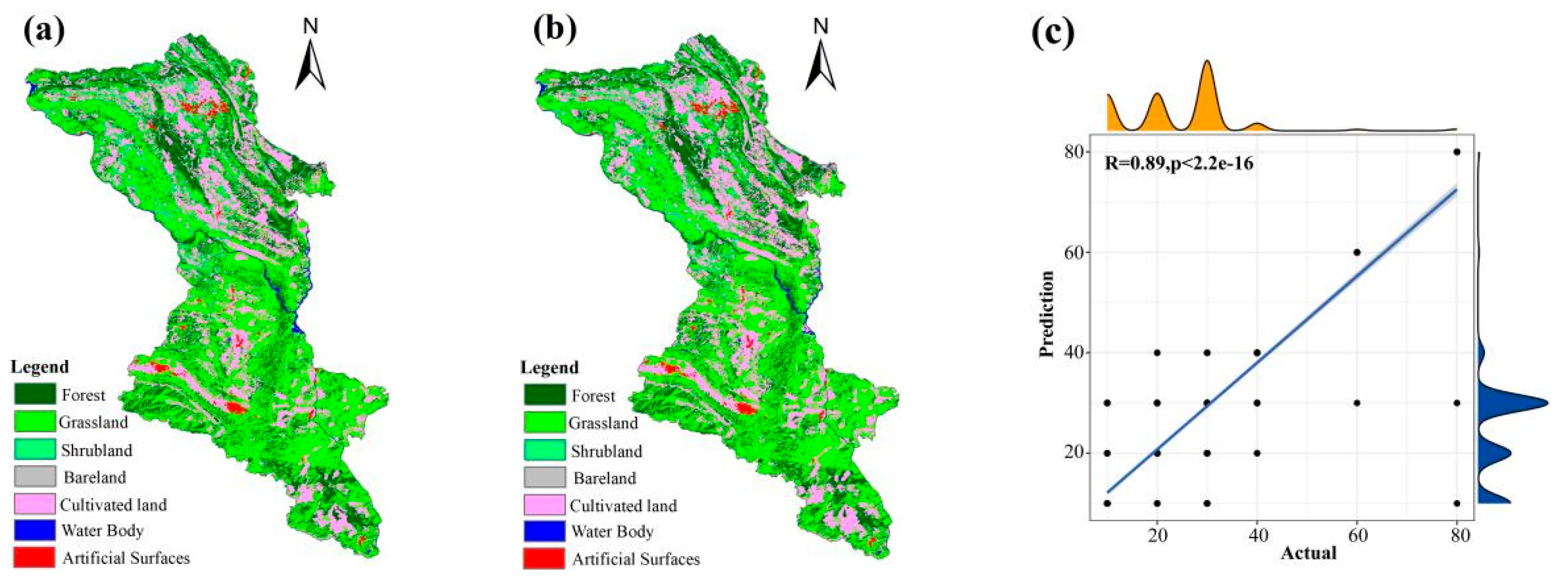
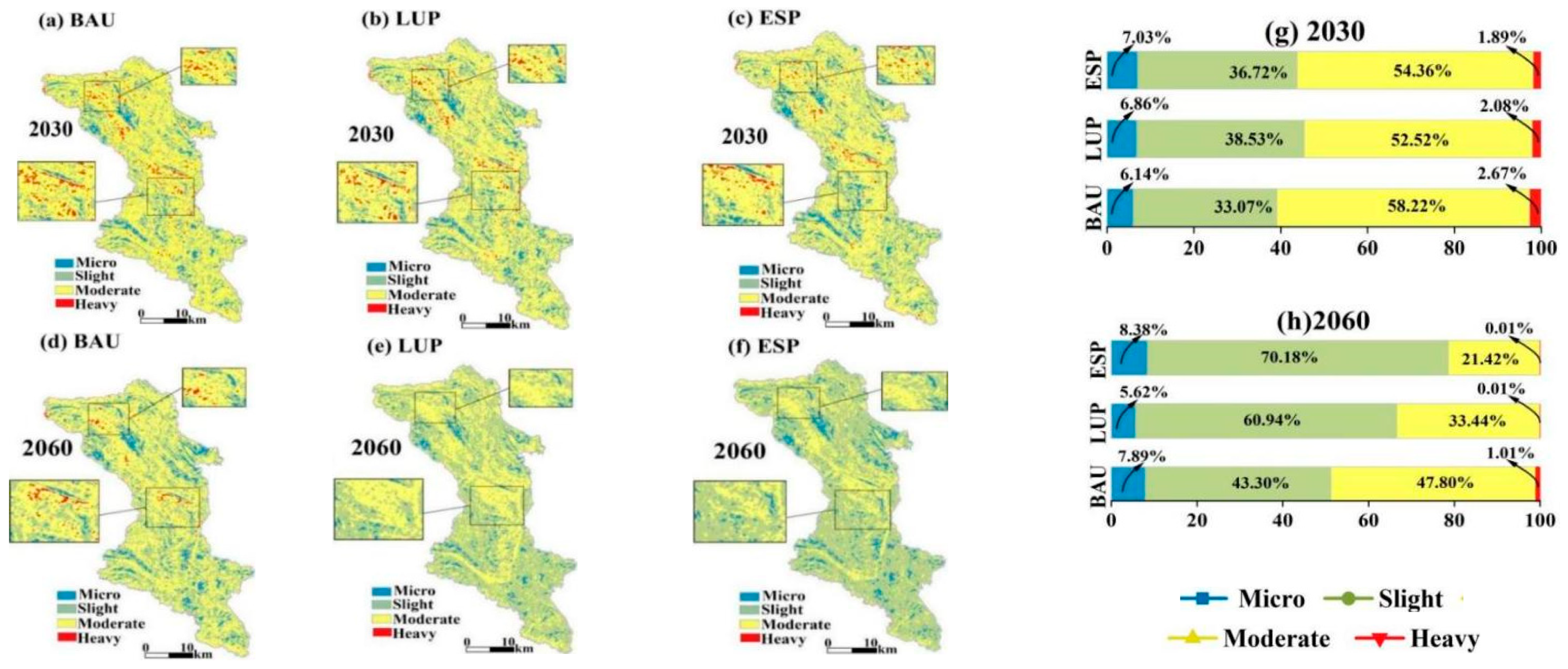

| Data | Source | Year of Data Access | Spatial Resolution (m) |
|---|---|---|---|
| LULC | http://globeland.org/ | 2000, 2010, 2020 | 30 m |
| DEM | https://search.asf.alaska.edu/#/ | 2019 | 12.5 m |
| Elevation | Based on ArcGIS 10.3 from DEM | ||
| Slope | |||
| Aspect | |||
| Soil type | https://geocloud.cgs.gov.cn/ | 2008 | - |
| Lithology | - | ||
| Population density | WorldPop https://www.worldpop.org/ | 2020 | 1 km |
| Distance from the road | http://www.dsac.cn | 2020 | - |
| Basis of Judgment | Interaction |
|---|---|
| q(X1 ∩ X2) < min [q(X1), q(X2)] | nonlinear weakening |
| Min [q(X1), q(X2)] < q(X1 ∩ X2) < max [q(X1 ∩ X2)] | single-factor nonlinear attenuation |
| q(X1 ∩ X2) > max [q(X1 ∩ X2)] | two-factor enhancement |
| q(X1 ∩ X2) = q(X1) + q(X2) | mutually independent |
| q(X1 ∩ X2) > q(X1) + q(X2) | nonlinear enhancement |
| q Value | Elevation | Slope | Aspect | Lithology | Soil Type | Pop | DFR |
| 0.0117 | 0.0076 | 0.0014 | 0.0119 | 0.0467 | 0.1309 | 0.1078 |
Disclaimer/Publisher’s Note: The statements, opinions and data contained in all publications are solely those of the individual author(s) and contributor(s) and not of MDPI and/or the editor(s). MDPI and/or the editor(s) disclaim responsibility for any injury to people or property resulting from any ideas, methods, instructions or products referred to in the content. |
© 2024 by the authors. Licensee MDPI, Basel, Switzerland. This article is an open access article distributed under the terms and conditions of the Creative Commons Attribution (CC BY) license (https://creativecommons.org/licenses/by/4.0/).
Share and Cite
Wu, X.; Zhou, Z.; Zhu, M.; Wang, J.; Liu, R.; Zheng, J.; Wan, J. Quantifying Spatiotemporal Characteristics and Identifying Influential Factors of Ecosystem Fragmentation in Karst Landscapes: A Comprehensive Analytical Framework. Land 2024, 13, 278. https://doi.org/10.3390/land13030278
Wu X, Zhou Z, Zhu M, Wang J, Liu R, Zheng J, Wan J. Quantifying Spatiotemporal Characteristics and Identifying Influential Factors of Ecosystem Fragmentation in Karst Landscapes: A Comprehensive Analytical Framework. Land. 2024; 13(3):278. https://doi.org/10.3390/land13030278
Chicago/Turabian StyleWu, Xiaopiao, Zhongfa Zhou, Meng Zhu, Jiale Wang, Rongping Liu, Jiajia Zheng, and Jiaxue Wan. 2024. "Quantifying Spatiotemporal Characteristics and Identifying Influential Factors of Ecosystem Fragmentation in Karst Landscapes: A Comprehensive Analytical Framework" Land 13, no. 3: 278. https://doi.org/10.3390/land13030278
APA StyleWu, X., Zhou, Z., Zhu, M., Wang, J., Liu, R., Zheng, J., & Wan, J. (2024). Quantifying Spatiotemporal Characteristics and Identifying Influential Factors of Ecosystem Fragmentation in Karst Landscapes: A Comprehensive Analytical Framework. Land, 13(3), 278. https://doi.org/10.3390/land13030278







